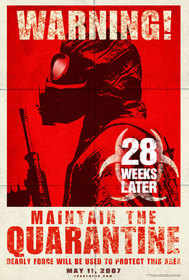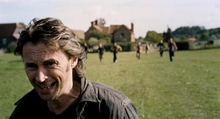Our editor-in-chief Nate Yapp is proud to have contributed to the new book Hidden Horror: A Celebration of 101 Underrated and Overlooked Fright Flicks, edited by Aaron Christensen. Another contributors include Anthony Timpone, B.J. Colangelo, Dave Alexander, Classic-Horror.com's own Robert C. Ring and John W. Bowen. Pick up a copy today from Amazon.com!
28 Weeks Later (2007)
In 1979, Roger Ebert called George A. Romero’s Dawn of the Dead “an ultimate horror film”1 and, in a separate review a few days later, cited its horrifying, satiric, and well-crafted elements as combining to make it such2. I am a huge Dawn of the Dead fan (as I write this, there is a Flyboy action figure on my desk), and ever since first watching it in college, I have waited for another zombie film with insight and terror comparable to that of Romero’s masterpiece. Enter the sequel to Danny Boyle's 28 Days Later, Juan Carlos Fresnadillo's 28 Weeks Later, another ultimate horror film.
28 Weeks Later takes place twenty-eight weeks after the original spreading of the virus (as opposed to twenty-eight weeks after the previous film). All of Great Britain has been wiped out, except for a few survivors here and there, and the American government has moved in to eradicate any remnants of the plague and begin rebuilding the country. Though the virus has been officially declared wiped out, the American military occupation remains. Now the country's surviving citizens are returning to take up residence in apartment buildings in a small, secured part of the country until the rest of it can be explored and declared safe. When the virus resurfaces in the middle of this closely confined country, ultimate chaos ensues.
There is some obvious commentary here on America's occupation in Iraq. If victory has been declared, why is the military still there? In this case, it's either because they're really not a hundred percent sure of their victory, though they do seem pretty confident, or, more likely (at least in the movie's case), because they just like being in control. When the outbreak does occur and the military's numbers are no match for controlling it, their only option is to kill everyone. The thing is, though, that the killing of innocents really legitimately is their only option in the situation that has arisen. Otherwise, the entire continent is at risk of falling to the Rage virus. Their mistake was in believing so confidently that they could control the whole situation in the first place. It is the most overarching of the film's many horrors.
The most impressive thing about 28 Weeks Later is how scary it is, and in multiple ways. The infected are as vicious as ever, and their violence would have been enough, but this film takes it to the extreme. Their viciousness provides for jump scares galore, but they are warranted given the nature of the epidemic, and they are not overused. These scares also give the quieter moments unbelievable tension. At one point in the film, we follow a young child alone in a dark place in which there might be, and probably are, some of the infected. The only sound is his shaky breathing. When I saw this in the theater, I was so on-edge that I realized I was breathing the exact same way. This all paves the way for subtle scares, too, such as the moments when an infected is simply standing or walking by in the background. When one of these disappears, you know it could be anywhere, but all you can do is push forth and pray for luck.
Another aspect of the movie that paves the way for its horror is the fact that it is so well written. I have seen few films so true to the story that it progresses with total disregard for its characters. This is a good thing. No one is kept alive just because the plot needs them or because the story has invested too much in them. It's as if the writers aren't even sure themselves if the film is going to make it to a satisfactory end. Of course, this is how a horror film should be. It creates a world where anything truly can happen to anyone at anytime, and survival is not at all guaranteed.
The one main aspect of this film that could be seen as a flaw is the set of circumstances under which the outbreak reoccurs. The way the virus itself comes back is almost cheating, and the way in which it is able to begin its initial re-spreading is a great coincidence. All the characters involved just so happen to be connected to the only other characters who could open the door for the virus to enter the population. These coincidences, however, are permissible because the film is more of a "What if?" than a prophecy; it's asking what this type of situation could be like rather than claiming that something specific is going to eventually happen to us.
I mentioned Dawn of the Dead at the beginning of this review, and my instinct to do so might have been because Romero’s influence is clear in 28 Weeks Later. Filmmaker Roger Avary likened 28 Days Later to Romero’s The Crazies3, and the resemblance is even more clear in this sequel. Not only is the premise nearly identical, but now there are the military personnel taking control of the area, gas-masked hazmat soldiers with flamethrowers, and a group of survivors being hunted both by the infected and the military, all of which are present in The Crazies. Also, like one of Dawn of the Dead’s famous moments, this movie even has a helicopter blade kill scene (multiplied about forty-fold). The basic difference between 28 Weeks Later and Dawn of the Dead (and other Romero films) is that whereas the latter focused on providing intelligent, socially aware horror, the former focuses on fast, breathless horror. The underlying themes are there, but they just aren’t as prominent or complex as those of Dawn. That is not a flaw, though. It is merely a difference. This is one of the best horror films of the decade.
This review was originally published in a slightly different form on The Sci-Fi Block on August 20th, 2008.
1. Ebert, Roger. "Interview with George Romero." Rogerebert.com. Originally published in the Chicago Sun-Times on 29 April 1979. Retrieved 15 September 2008. <http://rogerebert.suntimes.com/apps/pbcs.dll/article?AID=/19790429/PEOPLE/904290301>
2. Ebert, Roger. "Dawn of the Dead." Rogerebert.com. Originally published in the Chicago Sun-Times on 4 May 1979. Retrieved 15 September 2008. <http://rogerebert.suntimes.com/apps/pbcs.dll/article?AID=/19790504/REVIEWS/905040301>
3. Avary, Roger. Audio Commentary. "Day of the Dead (Divimax Special Edition)." Anchor Bay Entertainment. Published 19 August 2003.










garbage horror flick...first
garbage horror flick...first was classic, this is shit.